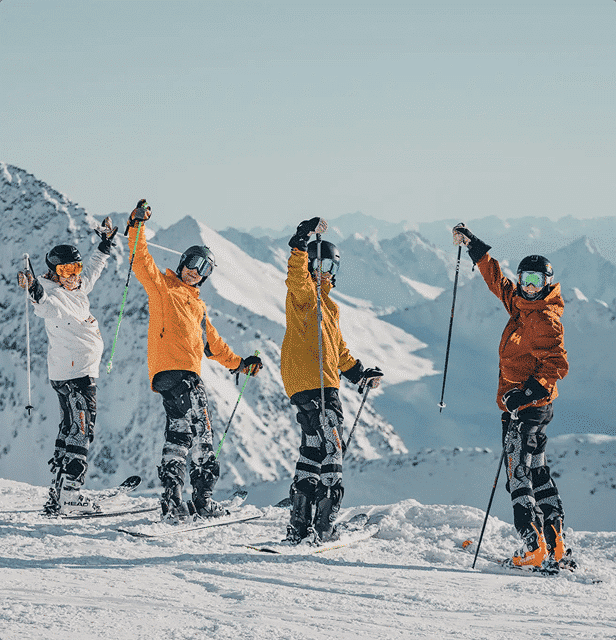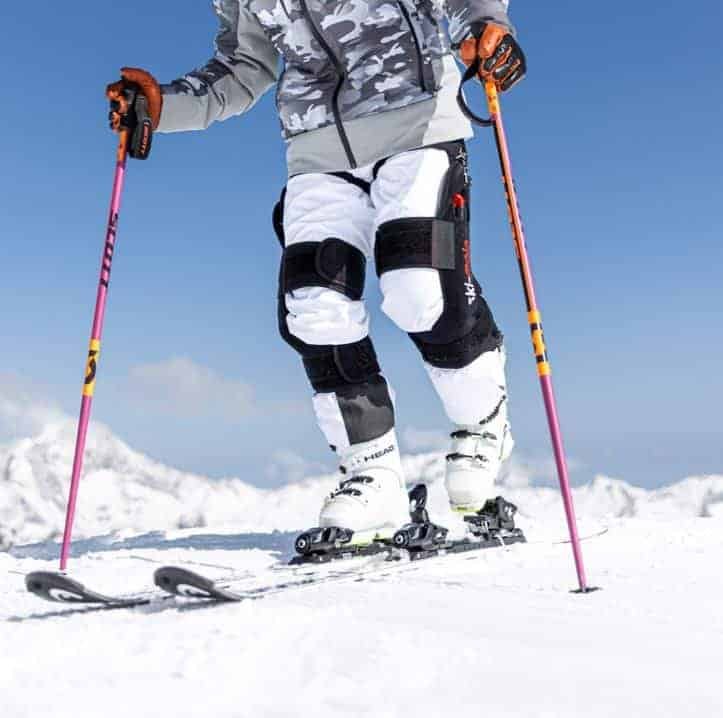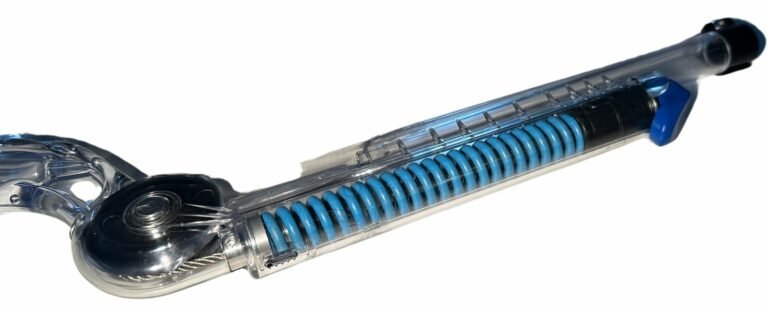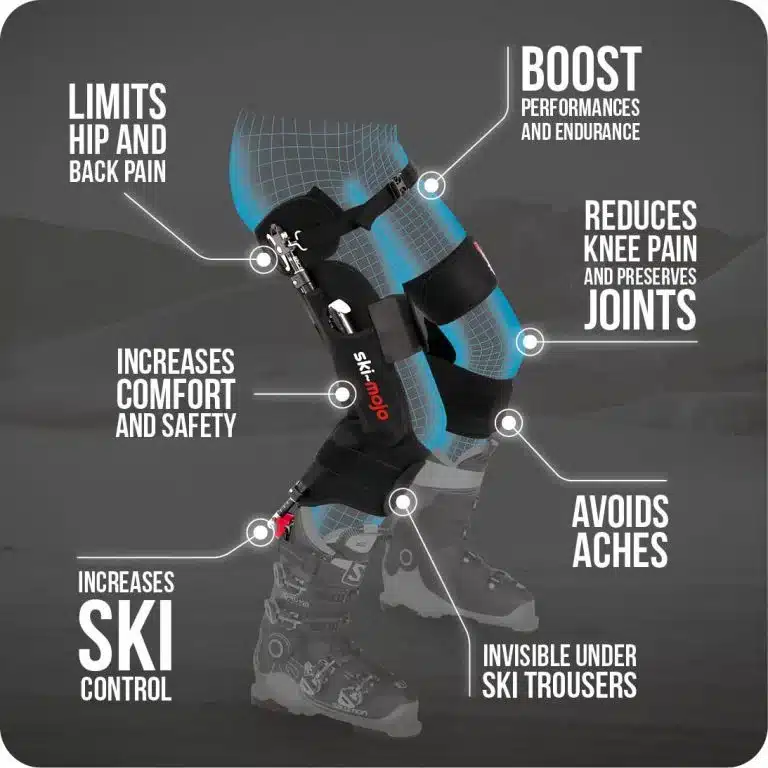Explore the different benefits of Ski~Mojo
01. Improves your endurance and performance
Even when you are in great shape and well trained, the pleasure of skiing increases with intensity. But when the slopes are long and steep, your quadriceps eventually burn out and force you to take a break, breaking your rhythm.
The Ski~Mojo then reduces muscle strain, saves 30 to 40% of energy and restores it over time. The result: more lightness, more turns, more intensity and less fatigue, while preserving the sporting dimension of skiing since the muscular effort is simply distributed differently.


02. Two powerful springs activated whenever you want!
Moreover, unlike a traditional brace, which is limited to lateral knee support, the Ski~Mojo absorbs shocks and vibrations from the terrain, allowing you to ski more comfortably while also reducing stress on all joints (knees, hips, and back).
More than 40,000 skiers have adopted the Ski~Mojo and recommend it to their friends. If you’re wondering whether it will be effective for you, we know the answer will be YES in more than 95% of cases, but if you’re skeptical, give it a try!
Please note that, like many other pieces of equipment designed to make sports easier, longer-lasting, or safer (such as an electric-assist bicycle), the Ski~Mojo is not a medical device.

03. Preserves your knees
By analyzing balance control on a force platform, the study by Moret and De Gunsch finds that in a static speed-seeking position, the distance traveled by the center of pressure is shorter when using the Ski~Mojo.
This would suggest that the equipment also has a positive influence on the skier’s balance control.
Case study:
Since 2008, two studies have been conducted on the impact of the Ski~Mojo on muscle activity.
Electromyography revealed that with the Ski~Mojo:
The energy savings felt in the work of the quadriceps is therefore real and quantified. Several studies have also established the importance of the hamstrings/quadriceps (H/Q) ratio in protecting the anterior cruciate ligaments. By analyzing the results of the EMG (electromyography), it is noted in the laboratory that the use of the Ski~Mojo significantly improves this ratio (by 27%), and this trend is confirmed during Ski~Mojo trials on the slopes (studies conducted by the scientific department of the French Ski Federation). This would tend to reduce knee laxity and thus protect the ACLs.
Considering that fatigue is a factor that increases the risk of ACL injuries, and that the Ski~Mojo also reduces fatigue, it is highly likely that the risk of injury decreases proportionally.

Fatigue is probably one of the main causes of skiing accidents. It can be avoided through proper physical preparation, but few skiers follow such a regimen. The Ski~Mojo helps delay the onset of this fatigue by reducing the perceived weight on the legs by about one-third, while balancing the work between the hamstrings and quadriceps muscles.
This allows skiers to better control their trajectories and maintain the muscle freshness needed to react effectively in case of emergencies. With less lactic acid buildup, muscles respond faster and more vigorously. Finally, the Ski~Mojo improves edge grip by “loading” and bending the ski more efficiently, especially on hard snow. This enables more precise handling.
At the end of the day, users report fewer muscle aches, thus contributing to an overall better experience on the slopes while reducing the risk of fatigue-related injuries.
05. No Batteries, No Electronics
In a world where everything is becoming electronic, it is tempting to think that a motorized device, equipped with batteries or smart chips, would necessarily be the most modern and efficient solution. Yet the reality of skiing – a sport of speed, endurance and precision – imposes very specific requirements.
Unlike motorized or electronic systems, the Ski~Mojo works without batteries, without a motor, and without recharging. Entirely mechanical, it is robust, built to last and resists both cold and moisture. Result: equipment that is always ready, with no risk of failure, whatever the mountain conditions.
Its responsiveness is immediate: no latency like with motorized devices, which is essential in a sport that demands perfect precision and an instant reaction from the legs.
Above all, unlike other exoskeletons, the Ski~Mojo is cleverly connected to the ski boots: it transfers about one third of your body weight directly to the ground. This unique principle provides the real relief of knees and thighs. Devices that do not use this technology only shift the load… to the calf, without effective relief.
The Ski~Mojo is also simple and practical: no electronic maintenance, no charger to carry, no stress about autonomy. Moreover, its purely mechanical design makes it a durable and eco-friendly solution, repairable if needed, that will support you season after season without ever failing.
In conclusion, the Ski~Mojo is not only a technological innovation, it is a solution designed for skiers: robust, reliable, responsive and simple. Where motorized and electronic systems quickly reach their limits, the Ski~Mojo guarantees pleasure, safety and performance over time. With the Ski~Mojo, you don’t need electricity to multiply your energy: your legs are enough.

Ski~Mojo delays fatigue to such an extent that it enables young athletes to ski very long distances without difficulty. Here, 8min30 of non-stop carving in Saas Fee (1700m vertical drop without any break)

with the Ski~Mojo, skiing remains a sport, but it becomes more of an endurance activity. It allows you to ski longer without exhausting your muscles because it promotes the repetition of the flexion-extension movement. Therefore, it does not weaken the quadriceps muscle mass.

a scientific study shows that the Ski~Mojo increases the workload on the hamstrings by 10% while reducing the effort of the quadriceps by 35 to 40%. This improves muscle balance, providing better protection for the anterior cruciate ligaments.

if you want to fully enjoy your skiing days, improve your performance, race down the slopes, or simply keep up with your more athletic children, the Ski~Mojo is the ideal solution. It will allow you to ski longer, with more ease and less pain. Don’t hesitate to try it and form your own opinion.

Learn more about

The Ski~Mojo is a device based on a technology that uses the power of a spring. The kinetic energy stored during knee flexion is released during extension through the decompression of the spring.
With the recommended adjustment in the user manual, the Ski~Mojo will support 1/3 of your body weight, which your legs will no longer have to bear. However, it’s easy to adjust the assistance according to your specific needs.
The articulated system is connected to the ski or snowboard boot shell (temporary connection during a trial) and to a comfortable under-seat harness.
The structure is inserted into a neoprene sleeve that keeps it in place. Since its primary purpose is not to provide lateral knee support, the neoprene should not be too tight. It adapts to each person’s morphology (hip circumference, tibial and femoral length). The whole system is therefore comfortable and quickly becomes unnoticeable.

Following a glittering career that included four Winter Olympic Games, seven World Championships, Alcott continues to work as a race coach with CDC Performance, a company she set up with her husband and former British Team Ski Racer, Dougie Crawford.
After a serious knee injury in March 2016, and subsequent operation and rehabilitation, Alcott used the Ski~Mojo for the first time and not only found it valuable as a knee support, but also for improving performance over long periods of time on the mountain.

Select your region